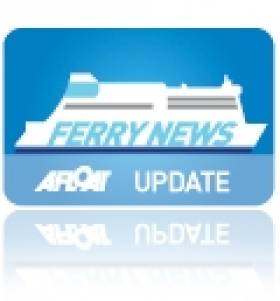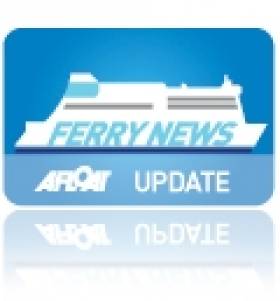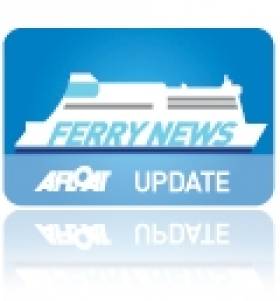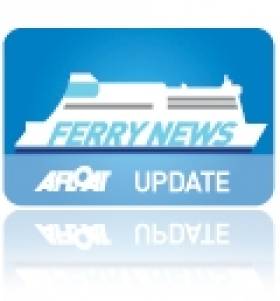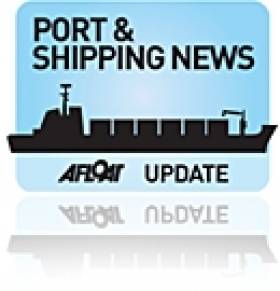Displaying items by tag: CalMac
CalMac’s Summer-Only Mull of Kintyre Service Extended into 2015
#CalMacKintyre – Caledonian MacBrayne's Ardrossan-Campbeltown summer-only service ended in late September, writes Jehan Ashmore.
The Scottish ferry operator originally had a trial pilot-period of two years to assess its viability and this has been extended into a third year with sailings to resume in 2015.
When CalMac launched the service linking Ardrossan (Aryshire) and Campbeltown (Argyll), this was their first new route for almost two decades. The 1 hour 40 minute service is part of a Scottish Government's final Ferries Review that covers ferry operations over a timeframe up to 2022.
Sailings started last May and once again it was the stalwart, Isle of Arann (1984/3,296grt) that carried out crossings enabling more than 600 passengers and 60 plus vehicles to be transported on this scenic route.
The summer service is to reinvigorate tourism in these regions and opening up interesting travel options to explore southern Scotland and where a round trip could include a stopover to Brodick, Isle of Arann dubbed Scotland in miniature. This option is only scheduled on Saturdays and from the direction of Campeltown to Ardrossan.
In addition Isle of Arann boosted capacity on the Ardrossan-Brodrick. The 55-minute service across the Forth of Clyde is operated year-round by Caledonian Isles.
In December a timetable for the 2015 season of the Ardrossan-Campbeltown route is due to released on the CalMac website.
Readers may recall that a trip from Northern Ireland to link in with the Campbeltown-Ardrossan service could be achieved by using Kintyre Express operations from Ballycastle to the port at the southern tip of the Mull of Kintyre.
The high-speed RIB based and 'foot' passenger only service ceased crossings also last month.
#MullofKintyre – Following last year's launch of Caledonian MacBrayne's Ardrossan-Campbeltown summer-only service, the Scottish ferry operator's first new route in twenty years, is to resume service for this season, writes Jehan Ashmore.
Sailings start this Thursday, 1 May and run till 28 September on the link between Ardrossan on the Firth of Clyde and Campeltown near the southern tip of the Mull of Kintyre.
It is understood the car-ferry, Isle of Arann (1984/3,296grt) will operate the 1 hour 40 minute service, which will enable more than 600 passengers and 62 vehicles to be transported on this scenic route.
The summer service is to re-invigorate tourism to these regions and allows for a boost in additional sailings on the Ardrossan service to Isle of Arann using the port of Brodick. Isle of Arann will join the 55-minute long routes main car-ferry, Caledonian Isles.
The route opens up interesting travel options to explore southern Scotland and where a round trip could include a stopover to Brodick on the Isle of Arann, affectionately known as the 'Scotland in miniature'. This can be achieved as the summer-only service will (only on Saturdays) sail from the direction of Campeltown to call via Brodick, Isle of Arann before arriving in Ardrossan.
Or if time restricted, a round-trip excursion from Ardrossan to Brodick where the summer schedule is to be increased in frequency up to September.
The nearest port to Ardrossan in Ayrshire, for those travelling across from Northern Ireland is Troon where P&O Ferries 'Express' seasonal-only fast-ferry service from Larne reopened last month.
Alternatively there are conventional ferry services also running from Larne to Cairnryan with the same operator or Stena Line's 'Superfast' ferry sailings from Belfast to Cairnryan.
In addition there is a third option, Kintyre Express 'foot'-passenger only Ballyscastle-Campeltown route operated by high-speed RIB craft. The passenger-only service would at least permit a circular route tour in either direction to encompass the Glens of Antrim, Mull of Kintyre, Forth of Clyde options and Dumfries & Galloway.
If going clockwise, Ballycastle which also has the ferry service to Rathlin Island, would involve firstly crossing to the Mull of Kintyre and then to Ardrossan, unless taking the Saturday-only sailing as mentioned to Isle of Arann as an added attraction.
Finally the last leg of the circuit would be to take a North Channel ferry from Cairnryan to either Larne or arrive in Belfast Lough.
Final Fortnight of CalMac’s New Pilot Campbeltown-Ardrossan Ferry Service
#NewFerryRoute – Caledonian MacBrayne's first season running the new route linking Campbeltown (Mull of Kintyre) and Ardrossan (Firth of Clyde) is to end sailings within a fortnight, writes Jehan Ashmore.
As previously reported the Campeltown-Ardrossan route began operating in May. On (Saturdays only) the service includes an en-route call via Brodick on the Isle of Arann. This is Caledonian MacBrayne's (CalMac) first new route in nearly 20 years.
The thrice weekly operated service which is running on pilot basis and ends on Sunday 29 September. The new route was to encourage boosting tourism and trade opportunities throughout the regions of Kintyre and Argyl.
Serving the crossings is the 3,296 tonnes Isle of Arran, a veteran of the ferry company fleet built in 1984 and which has a capacity for 659 passengers and 62 cars. For sailings timetable and more about the new route visit this link.
Caledonian MacBrayne have been named by the British Travel Awards (BTAs) as one of the shortlisted contenders for the following awards of 'Best Ferry Company' and 'Best Holiday Magazine'. This year's BTA awards gala dinner ceremony takes place on Thursday 31 October in London.
New Firth of Clyde Ferry Service
#NewFerryRoute – A new ferry route linking Campeltown on the Mull of Kintyre peninsula and Ardrossan on the Firth of Clyde via the Isle of Arann started last month, writes Jehan Ashmore.
The introduction of the new service between Kintyre and Argyll is Caledonian MacBrayne's (CalMac) first new route in nearly 20 years.
The new service is to benefit both communities from a boost in tourism and trade opportunities according to Scotland's Deputy First Minister Nicola Sturgeon.
Since the service started on 23 May, the route which is operating on a pilot basis to 28 September is running to three sailings weekly throughout the summer, with an en-route call to Brodick on the Isle of Arran on Saturday's.
The 3,296 tonnes Isle of Arran is running the new service and the veteran of the Caledonian MacBrayne fleet built in 1984 has a capacity for 659 passengers and 62 cars. For sailings timetable and more about the new route visit this link.
As previously reported on Afloat.ie, Campeltown is also served by another operator, Kintyre Express which two years ago started a passenger-only service to Ballycastle, Co. Antrim.
The route is only 50km /30 miles long and uses RIB craft which take 1 hour 30 minutes to complete the passage.
The Timber Traders and Days of Old Irish Sea Shipping Companies
#PORTS & SHIPPING- The general dry-cargo vessel, Red Duchess berthed at Ardrishaig on Scotland's west coast at Loch Fyne today, after completion of a voyage from Waterford, writes Jehan Ashmore.
The 1969-built coaster rounded the Hook Head Lighthouse yesterday around noon, having departed Belview on Waterford Estuary. She is engaged on the Irish Sea timber trade, which have been the mainstay of the cruiser stern-vessel's career (see PHOTO).This feature maybe commonplace among yachting craft, yet it is an increasing rare feature, to be found on commercial ships these days.
Her builders were Bodewes Hoogezand Scheepswerf, Bergum of The Netherlands, though the veteran vessel received a modernisation programme in 1995. In addition to the 1,285grt Red Duchess, her fleetmate Red Baroness (1979/964grt) is also actively employed on the same trade.
Each vessel has a single 80m box-hold which can also handle coal, fertiliser, salt and stone. The UK flagged vessels are owned and managed by Coast Lines Shipping based in Midleton, Co. Cork which was established in 1981. For photos of the fleet and technical details, click HERE.
The name of the Irish shipping company revives the similarly named Coast Lines which was synonymous with the British & Irish Steam Packet Co. Ltd otherwise known as B+I Line. By 1917 the Coast Lines group operated seven Irish shipping companies and held all the shares in B+I Line.
The group also had a half interest in David MacBrayne, which was together acquired in the same year by Lord Kylsant's Royal Mail Steam Packet. It was during the Kylsant period that one of their vessels, the 696 ton Lochfyne served David MacBrayne. The Kylsant shipping empire collapsed and Coast Lines regained independence in 1935.
It is apt to have these historical associations as successors to David MacBrayne, now Caledonian MacBrayne (CalMac) are Scotland's largest island ferry network which includes the Loch Fyne ferry (PHOTO) route of Portavadie-Tarbert with the remote location of Ardrishaig further up the Loch.
By 1965 Coast Lines sold their British & Irish (including the associated City of Cork Co.) to the Irish Government and the remaining part of the company was purchased by P&O in 1971. This marked an end of era, with the names of several Irish Sea freight and ferry operators slipping away.
As for Coast Lines Shipping, which was established in 1981, both Red Duchess and Red Baroness are on a time charter arrangement with JST Services. The Ayr-based company provide an integrated shipping, handling and road haulage timber business in addition to the carriage of other cargoes.
Asides serving Ardrishaig, the red-hulled vessels call to their adopted homeport of Ayr, Campbeltown and Sandbank. In addition they call to Troon, where both coasters are registered (see PHOTO). From these ports they sail to Irish ports, in particular Derry, Youghal and Passage West, a privately-owned wharf in the centre of Cork Harbour.
Timber products can include logs, which are loaded by a grabber as depicted in this PHOTO taken at Passage West. The facility also deals in scrap-metal cargo, where a mounting pile is clearly evident on the quayside, awaiting to be disposed for export.
- Shipping
- Irish ports
- irish sea
- Red Duchess
- Coast Lines
- Hook Head Lighthouse
- Caledonian MacBrayne
- B&I Line
- Ports & Shipping news
- timber
- British & Irish Steam Packet Co
- Coast Lines Group
- Coast Lines Shipping Ltd
- JST Services
- Belview Waterford
- Red Baroness
- Irish Sea shortsea coasters
- Irish Sea fshipping companies
- CalMac
- Royal Mail Steam Packet
- Irish Sea coasters
- Irish Sea short sea shipping
- Loch Fyne Scotland
- David MacBrayne
- Passage West Cork Harbour
- Cork Harbour
- PortavadieTarbert
- MV Isle of Cumbrae


























